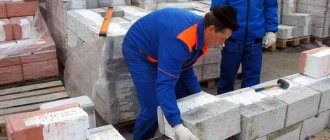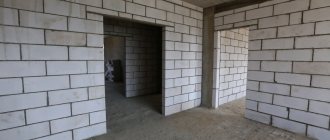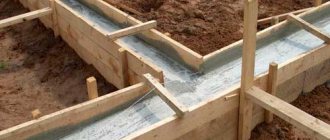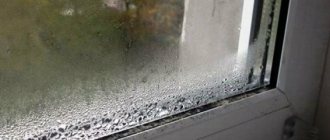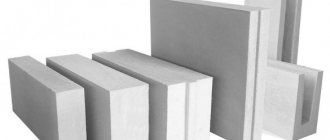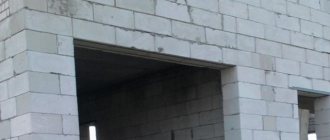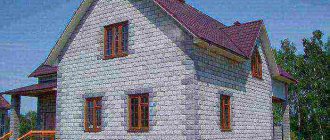To date, professional masons have not come to a consensus on what composition is best for laying foam concrete blocks. The subject of dispute is cement-sand mortar and construction adhesive. Due to the small volumetric mass of the material, its porous structure and low level of strength, both of these compositions have their advantages.
Composition and proportions of the solution
For the construction of walls made of foam blocks, a cement-sand mixture is used in a ratio of 1:4. Its disadvantage is that the seams between masonry elements filled with mortar turn into “cold bridges”. This significantly reduces the thermal insulation qualities of the walls.
To improve the properties of the mixture, special additives are used. Based on this, the solution for laying foam concrete blocks differs in composition from its traditional counterpart. It includes:
- Portland cement grade M-400;
- river quartz sand;
- foam additive;
- plasticizing additive;
- slaked lime;
- water.
Read how to choose the right cement here.
A foam additive added to the masonry mixture actively draws air molecules into it and binds it. This significantly increases the thermal insulation qualities of the seams. However, the strength level of the solution decreases.
In most cases, liquid resin is used as a foam additive. Sometimes other foaming ingredients are used.
A plasticizing additive makes the solution more elastic. Thereby:
- the mixture shrinks less;
- its astringent properties increase;
- the service life of both the seams themselves and the foam concrete blocks increases.
Adding slaked lime to the solution makes it porous and drier, thereby increasing its thermal insulation qualities.
All additives for masonry mixtures are sold in construction stores. They are inexpensive. The price of a solution mixed with foaming and plasticizing additives is not much different from the cost of a traditional analogue. After all, such additives require only about 1-2% of the total volumetric mass of the mixture.
It is not necessary to use additives in larger quantities. Then they will not increase, but decrease the quality of the masonry mixture.
The search for optimal proportions of masonry mixture for foam blocks does not stop now. So, when a large volume of slaked lime is added to the solution, up to 50% of the more expensive Portland cement is saved. However, the strength characteristics of the mixture decrease.
Based on this, Portland cement is not worth saving. The optimal solution is to adhere to the traditional proportions of binder and sand 1:4. You can add slaked lime to them (about 5% of the volume of cement).
It is forbidden to add clay to the solution for foam blocks. It reduces the strength of the bond of masonry elements and increases the risk of wall collapse.
Laying foam blocks with glue and mortar
High-quality foam concrete blocks are characterized by a regular geometric shape. In this case, special glue can be used to lay walls from them.
Advantages of the ready-made masonry mixture:
- Thin masonry joints do not turn into cold bridges.
- Working with glue is less labor-intensive, and laying walls with it is faster.
- The cost of plaster when finishing walls is minimal. This happens due to the evenness of the enclosing structures erected using the ready-made mixture.
Sometimes special masonry adhesive is replaced with a frost-resistant analogue for ceramic tiles. This practice is not wrong. The main thing is to completely fill the vertical and horizontal joints.
Most often, homemade cement-sand mortar with various additives is used for laying foam concrete blocks. Especially if the masonry elements have an irregular shape. Advantages of this solution:
- Low price of the resulting mixture.
- Possibility of leveling masonry when using low-quality blocks by increasing the thickness of the seams.
The disadvantages of using a homemade solution include the time and labor costs for its preparation.
Read this article to learn how to prepare the solution yourself.
Principles of laying foam concrete blocks
Before laying walls, the surface of the foundation must be covered with a waterproofing material, for example, roofing felt. It is necessary to begin the construction of walls by laying the corners. If there is a difference in height between them, then the highest corner is laid first, after which the rest are leveled to its level using a solution.
Therefore, before laying the first block, you need to take appropriate measurements. Next, a control thread is stretched between the outer blocks of the span being constructed, with the help of which the entire first row of foam blocks will be supported. Tension of the control cord is necessary when laying each row.
If the foundation is uneven, after laying the first row, be sure to allow the mortar to dry before continuing with the construction of walls.
When laying blocks of the second and subsequent rows, the mortar or glue is laid in an even layer, except in cases where the blocks are uneven. The solution must be applied not only to the horizontal, but also to the vertical surface of the elements of the previous row. After installing the block, its position is adjusted using a rubber mallet. This should be done with caution, since foam concrete is a rather fragile material.
Due to the high hygroscopicity (ability to absorb moisture) of foam concrete, there is a possibility of excessive absorption of water from the solution by the blocks. Therefore, in dry and hot weather, it is recommended to periodically spray the foam blocks with water from a spray bottle.
Foam block masonry must be reinforced.
This is done to protect the structure from shrinkage and temperature deformations, as well as to strengthen the areas most susceptible to stress. Reinforcement is carried out by placing reinforcement grooves in specially prepared grooves along the perimeter of the row or using other materials intended for this purpose. Such reinforcement is carried out on the lower and upper rows of walls, on every third row, as well as in the areas of design openings.
To summarize, we can say that laying lightweight concrete blocks is easier and more effective using specialized glue. However, this condition is only valid if they are manufactured with maximum dimensional consistency relative to each other. In some cases, it is impossible to do without the use of cement mortar.
To date, professional masons have not come to a consensus on what composition is best for laying foam concrete blocks. The subject of dispute is cement-sand mortar and construction adhesive. Due to the small volumetric mass of the material, its porous structure and low level of strength, both of these compositions have their advantages.
Consumption of mortar for masonry
It’s good if high-quality, smooth foam concrete blocks are used to build walls. Then, when calculating the required amount of solution, one should proceed from the fact that about 35-40 kg of the mixture is consumed per 1 cubic meter of masonry.
These numbers are approximate. They are valid when the construction of walls is carried out in one row and at a temperature range of +5/+25º. If the masonry is carried out in two rows, then vertical connecting seams will appear. As a result, the cost of the mixture will increase by 60-65%.
When calculating the consumption of masonry mortar, a joint size of 10 mm is used. But when the blocks have an irregular shape or their sizes vary, then the joints have to be made thicker. Because of this, the cost of mortar per 1 cubic meter of masonry increases.
Wherein:
- for single-row masonry, it is necessary to mix 50-60 kg of mortar per cubic meter of masonry;
- for double-row masonry you will have to prepare 80-90 kg of mixture.
Based on the calculations, you should purchase all the necessary materials to prepare the solution. Since they are approximate, the necessary adjustments will need to be made during the construction of the walls. Even if some materials remain, they can always be used on your own site.
Advantages and disadvantages of the adhesive mixture
Using adhesive for foam concrete has many advantages:
The small thickness of the seam between the elements practically eliminates the possibility of cold bridges.- Special glue increases the ability of foam blocks to maintain sound insulation and thermal insulation.
- Thanks to the additives included in the mixture, blocks placed on glue can be adjusted after even 15 minutes. This plasticity does not affect the quality of the solution.
- After hardening, the glue does not absorb moisture. And special antifungal additives help prevent mold and mildew from appearing in the seams of the blocks.
- Resistant to temperature changes. Cement mortar may crack at the seams due to the influence of temperature. Special glue for foam blocks does not react to such changes.
- The glue is vapor permeable, so foam block walls can “breathe”, that is, condensation does not accumulate inside the block.
- Foam block elements on glue last much longer than on conventional cement mortar.
- The adhesive mixture is environmentally friendly.
- Saving time and money. Since a thin layer of mortar needs to be applied to the blocks, it does not need to be mixed as often. And although the price for a bag of special glue is 2 times higher than that of cement, its consumption is 2 times less. The money savings are significant.
- This glue is stronger than cement and hardens faster. Therefore, construction work can be completed much earlier than when using cement.
- The glue applies evenly to the elements (if there are no lumps in it), and this increases the adhesion of the blocks. Thin, neat seams do not require additional processing or cleaning, the wall remains smooth, without glue sagging.
- The light weight of one bag allows you to work independently, without the help of others. And the material itself is easy to load and transport.
- It is not necessary to have a concrete mixer to mix the glue. It is enough to use a drill, a mixer, or even knead the solution by hand (for small volumes).
- The material does not crumble due to its long service life, does not shrink, and does not deform.
This article will not be objective if we do not also talk about the disadvantages of glue for foam blocks. There is only one negative side of the adhesive mixture - the high price of a bag of the mixture. It is approximately 2 times larger than a similar cement mixture. Because of this, laying foam blocks with glue is used mainly for the construction of small buildings.
Glue consumption will be small if the elements are smooth and do not have potholes. When foam blocks have voids and differences, then to fill these gaps and level the plane, you will need a lot of glue. Therefore, it is better to take 1-2 bags in reserve.
How to prepare a solution for laying foam blocks: step-by-step instructions
Before constructing a building from foam concrete blocks, you should first prepare all the necessary materials and tools for mixing the solution.
Required materials and tools
In the case of preparing a solution for foam concrete blocks, you won’t need much. If you make the mixture yourself, then from the materials you need to prepare Portland cement, quartz sand, the necessary additives, slaked lime and water. You will also need to prepare the following tools:
- a concrete mixer, or if it is not available, a large trough for preparing the solution;
- metal buckets;
- shovels and bayonet shovels.
Stages of mixing the solution
To make your task easier, you can simply purchase ready-made masonry adhesive. It can be found at any construction market or in a store. The rules for preparing the mixture are as follows:
- It is diluted with clean water in a ratio of 1 kilogram of dry solution per 200 ml of liquid. Or 5-6 liters of water per 25 kilograms of mixture (standard bag).
- Mixing is done in a bucket using a drill with a whisk attachment. This must be done carefully so that there are no unmixed dry lumps of the mixture left.
- When the solution is ready, it should be allowed to mature for 7-10 minutes. Next, you need to mix it again.
- The result should be a solution with a creamy consistency. It must be made plastic so that it does not spread when distributed over blocks using a notched trowel.
- The solution is applied to the foam blocks in a layer, the thickness of which should be 2-5 millimeters.
- If the mixture thickens, add a little water to it and mix well. The diluted glue must be used within 40 minutes.
The ready-made mixture is quite expensive, so it is better to save money and prepare the masonry mortar for foam concrete blocks with your own hands. How it's done:
- If you do not have a concrete mixer, then place the dry mixture in a trough or other large container. Do this at the rate of one scoop of Portland cement to four shovels of sand.
- Mix the ingredients thoroughly.
- Then add water with additives diluted in it - foam additive and plasticizer.
- After this, mix the solution until you get a homogeneous mass without lumps.
The resulting mixture should have a creamy consistency. If the solution is too liquid, add a little dry mixture to it; if it is thick, add water.
What is needed to build a house from foam blocks on your own?
The photo shows the processing of foam blocks.
If the construction of a house is carried out with the involvement of a construction team, they bring all the necessary equipment and tools with them.
But if the work is carried out independently, you need to prepare some equipment:
- container for preparing cement mortar or adhesive mixture;
- shovel;
- buckets;
- drill attachment for mixing the solution and drill;
- level;
- rubber hammer;
- hacksaw or saw for cutting blocks;
- corner for cutting;
- trowel for applying the solution;
- serrated trowel;
- film for covering masonry;
- grater for leveling,
- A constant source of water should also be provided at the construction site.
Basic rules for laying foam blocks and sequence of work
Photo – finished foam block masonry.
If you still decide to build a house yourself, it would be useful to familiarize yourself with how to do masonry correctly, as well as determine the order and sequence of the main stages of construction.
- Material selection:
- for a beginner, it is recommended to use adhesive compounds, since with their help it is easier to perform even laying, unlike cement mortar, which requires some experience to work with;
- An adhesive solution is prepared based on a dry mixture with the addition of water. For stirring, it is convenient to use a special mixing attachment on a drill;
- When preparing the solution, it should be taken into account that it must be used within a maximum of 20 minutes.
- Leveling corners and installing beacon blocks:
- a mooring cord should be secured at a distance of 2 mm from the side edge;
- place blocks underneath it along the perimeter at a certain distance from each other to avoid sagging;
- When rearranging the cord for a new row, it is tied to nails specially fixed in the seam of the masonry.
- Marking the building:
- window/door openings;
- places where internal partitions adjoin load-bearing walls;
- preparing, using a marking square and a hacksaw or saw, products of the required sizes for dressing the masonry and for intersections.
- Work should be carried out at temperatures from 5 to 25 ºС; at sub-zero temperatures it is necessary to use frost-resistant mixture compositions.
- Clearly and accurately observe the rows and graft the dressings of the rows.
- After laying the next row, it should be cleaned of splinters, dust and all unevenness should be removed using a construction float.
- The glue should be applied with a notched trowel.
- Be sure to follow the dressing rules, the classic version with an offset of half a block of the next row.
- Control of masonry accuracy:
- corners are checked with a wooden corner;
- the horizontal level is determined by the rule and the level;
- the verticality of the structure is controlled by plumb and level;
- detected excesses of the permissible error are corrected either with a plane or during the execution of the next row;
- after 2-4 rows, a level is used to determine how smooth the masonry is, and with a tape measure it is necessary to measure the length of the walls.
Photo - reinforcement of openings.
Advice from professionals
- Each additive must be added to the solution in a volume of no more than 1% of its total volume. Otherwise, the mixture will turn out to be of poor quality.
- You should not mix a lot of glue at once. Its volume should be such that the solution is enough for 30-40 minutes of work. Then the mixture begins to set and thicken.
- In summer, at high ambient temperatures, the solution must be protected from the sun's rays and periodically sprayed with water.
- The glue should be applied to the blocks with a special notched trowel or trowel.
To lay foam concrete blocks, it is necessary to use a cement-sand mortar with special additives. It must be prepared based on the exact proportions of the ingredients. It is extremely undesirable to overdo it with the amount of foam and plasticizing additives.
Check out the published video in the article. It describes in detail the features of the solution for laying foam concrete blocks and how to prepare it correctly:
